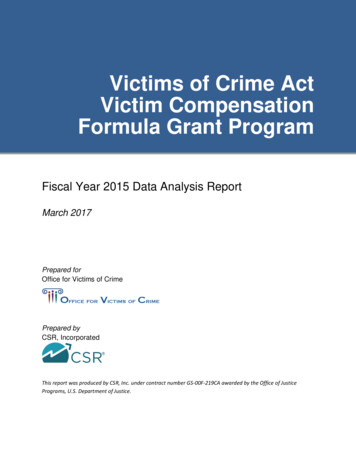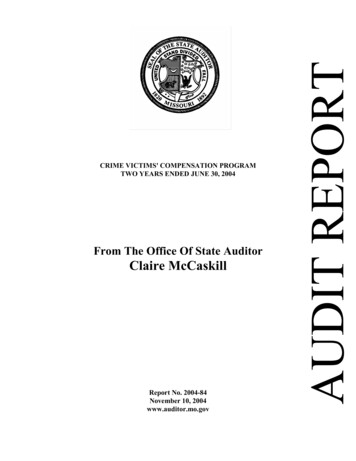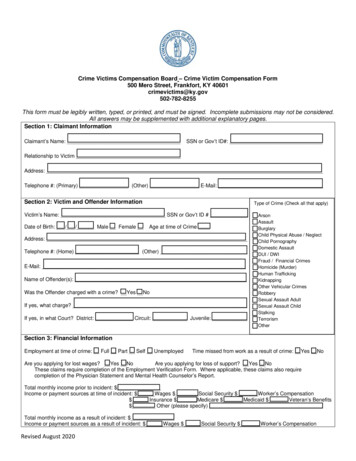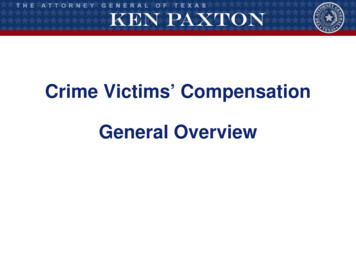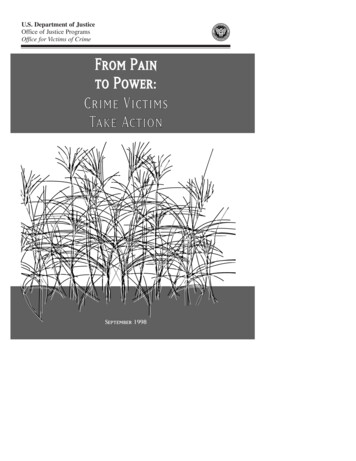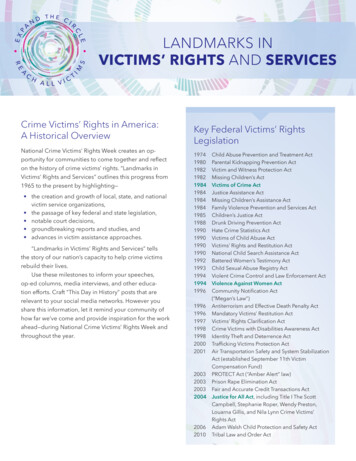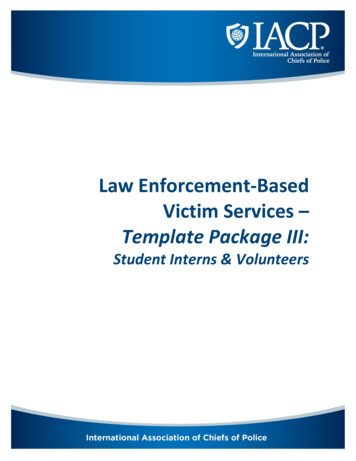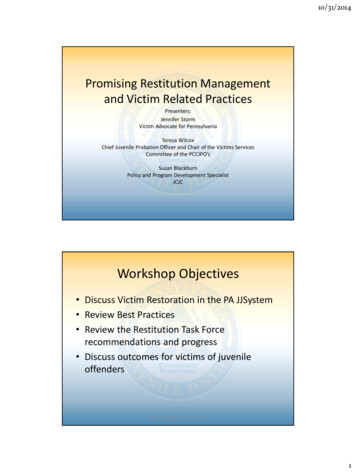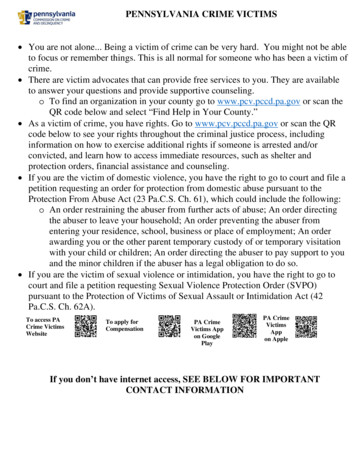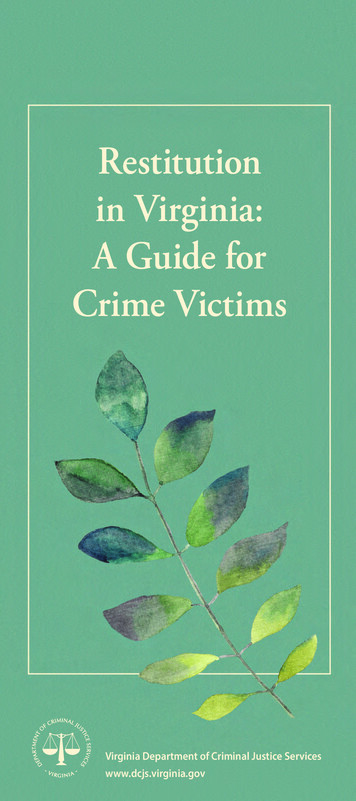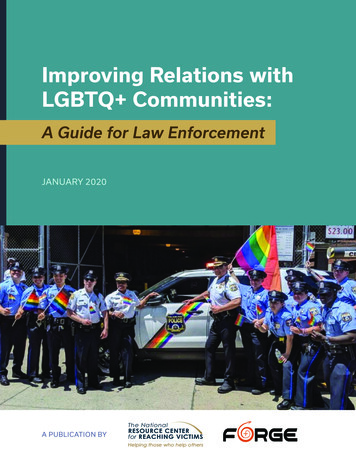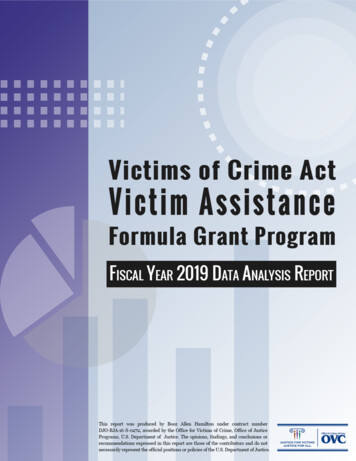
Transcription
INTRODUCTIONIn fiscal year (FY) 2019, over 3.3 billion was allocated to the Victims of Crime Act (VOCA) Victim AssistanceFormula Grant program. Fifty-six grantees funded 11,303 subawards to 6,837 subgrantee organizations, anincrease of 13 percent and 6 percent from FY 2018, respectively. In 2019 there were 13,817,598 total victims(which includes new and returning individuals) who received direct services and 4,496,832 anonymous contactsserved through hotline calls or online chats. Of the total, there were 7,029,181 unique individuals identified asnew clients served throughout the year, representing an 11.4 percent increase from FY 2018. 1 As the nature ofservice provision varies, some individuals will receive services one time while others might continue to receiveservices over many months.VOCA-FUNDED VICTIM SERVICE PROVIDERSIn FY 2019, nonprofit organizations were the most common subgrantee organization type, followed bygovernment agencies. Campus organization increased from FY 2018 by 23 percent.TRAINING AND COORDINATION ACTIVITIESAt the conclusion of each fiscal year, Victim Assistance program grantees answer narrative questions aboutgrant-funded activities that occurred in their state during the year. Of the 49 Victim Assistance programgrantees that submitted responses to annual narrative questions, 27 described planning or training events duringthe reporting period. Training events were wide-ranging and included topics such as vicarious trauma,compassion fatigue, safety and resilience, human trafficking, cultural sensitivity and diversity, grantadministration, and grant management. Planning events included working groups to develop and implement agrantee’s five-year strategic plan, meetings to develop and release calls for proposals, and meetings to planannual conferences.Victim service providers do not share personally identifiable information with other providers to ensure the privacy of victims. As such, this numbermay include duplicates in cases where victims received services from multiple service providers.12
Due to the number of partnerships that each grantee has, Victim Assistance program grantees listed a widevariety of agencies and organizations that they coordinate with to assist crime victims. These responses included(but were not limited to) child advocacy centers, local police departments, counseling service organizations, andsex abuse treatment centers. Of the 49 Victim Assistance program grantees, 46 described coordination servicesand responses.VICTIM DEMOGRAPHICSIndividuals who received assistance from VOCA-funded victim service providers had the option to self-reportdemographic information, including age, gender identity, and race/ethnicity. Although many victims chose toself-report all or some of their age, gender identity, and race/ethnicity, some victims declined to provide thisinformation and some subgrantee organizations were otherwise unable to track some or all demographic data. 2AgeGenderAge was self-reported by 65 percent of victims served.Gender was self-reported by 70 percent ofvictims served.Individuals who reported other gender had theoption to further describe their gender identity.Transgender was the most common response,and other responses included but were notlimited to non-binary, non-conforming, genderfluid, and intersex.There was a 17 percent increase in the number ofindividuals served who self-reported their age as60 years at the time of the victimization,representing the largest increase among age groups.In FY 2019, there were 1,187 organizations that did not track age, 906 organizations that did not track gender identity, and 1,320organizations that did not track race/ethnicity.23
Race/EthnicityRace/ethnicity was self-reported by 63 percent of victims served.Special ClassificationsSome victims self-report a special classification they experience to service organizations, as defined by thePerformance Measurement Tool (PMT). 3 This information helps providers increase their knowledge about thevarious conditions and needs facing victims, how these experiences, identities and unique needs may alter oraffect the healing process, as well as the best ways to address them when providing services. As theseclassifications are self-reported, the percentage reflected among all victims served with these qualities isunknown.In FY 2019, the number of individuals that self-reported per category ranged from 27,395 to 425,353.4There are eight special classifications in the Performance Measurement Tool: Deaf/hard of hearing, homeless,immigrants/refugees/asylum seekers, LGBTQ, veterans, victims with disabilities (cognitive, physical mental), victims with limitedEnglish proficiency, and other.4Individuals can self-report in one or more special classification.34
While the LGBTQ and Veteran classifications are among the smallest in comparison to the others, they had thelargest increase in individuals self-identifying, with a 33 percent and 26 percent increase, respectively. Homelesscontinues to be the second leading self-reported special classification in from FY 2018, representing 22 percentin FY 2019. Lack of affordable housing and homelessness is identified as a longstanding high need, or anemerging issue reported among many grantees.Of the individuals who disclosed a special classification, 11 percent self-reported as “other”, a 27 percentdecrease from FY 2018.5 Within the classification of “other,” the most commonly reported explanations includedrural (19 percent), substance abuse or addiction (11 percent), and older or dependent adults (9 percent).TYPES O F VICT IM IZAT IONVOCA-funded service providers reported the types of victimization experienced by the individualsserved, including both primary and secondary victims of crime. 6 , 7 There were 1,408,628 individuals whoreported experiencing multiple victimization types, representing a 24 percent decrease from FY 2018.5If individuals self-report a special classification under “other,” they are asked to provide further explanation detailing theclassification.See appendix A for the categorizations of victimization types.A primary victim is an individual who suffered direct harm because of a crime. A secondary victim is an individual whoexperienced indirect consequences because of a crime.675
The total number of victims served increased from FY 2018, and the number of victimizations within eachcategory increased proportionally. Similarly, violent crime victimization reported by VOCA-funded serviceproviders increased 13.6 percent from FY 2018 to FY 2019. This increase in victimizations may suggest that ahigher number of individuals are seeking victim services from VOCA-funded organizations after being victimized,or that more victims sought services across several months for their victimization.6
Mass violence represented the largest increase in victimizations between FY 2018 and FY 2019, with an increaseof 39 percent, followed by child abuse/assault (32 percent), human trafficking (27 percent), adult sexual assault(24 percent), and kidnapping (24 percent). Despite the percent increase in kidnapping, mass violence, and humantrafficking, the number of individuals experiencing these types of victimization remains low compared to othertypes of victimization. Domestic and family violence had the largest number of victimizations (3,691,192) but asmaller increase of 11 percent over FY 2018.Victim service providers indicated that victims experienced other victimization types as well, including violationof a court protective order, criminal mischief, disorderly conduct, and false imprisonment. States often reportedindividuals who receive notification services under “other victimization.” VNSs provide individuals withinformation pertaining to an offender or court case. As VNSs are typically automated, state agencies administeringthose services with VOCA funds may not know the victimization type for the individuals receiving notifications.7
DIRECT SERVICESIndividuals may experience a range of negative outcomesbecause of their victimization. They may also experiencesetbacks, sometimes due to the exacerbation of existingchallenges or instabilities in their lives. As such, it is vitalfor victims and their families to receive trauma-informed,culturally and developmentally appropriate services tohelp them work through the effects they are facing.Victims and their families often have various needs thatspan across multiple types of services. Victim experiencesare never the same, so organizations strive to tailor theservices provided on an individual basis.Services include, but are not limited to, physical, emotional, and psychological assistance. VOCA-funded servicesare reported in five main direct service categories, through a detailed list of categorized service types.Individuals may receive multiple services, and/or the same service multiple times as they work with a serviceprovider to address their victimization and promote healing and stability in their lives.8
SPOTLIGHT: BUREAU OF JUSTICE STATISTICSVICTIM SERVICES STATISTICAL RESEARCH PROGRAMIn 2017, the Bureau of Justice Statistics (BJS) conducted the National Census of Victim ServiceProviders (NCVSP), the first-ever nationwide data collection on all types of victim service providers(VSPs). This included an intentionally expansive approach and definition of providers, includingregardless funding sources, with results of the NCVSP released in November 2019. The purpose of theNCVSP and broader Victim Services Statistical Research Program is to define the size and scope of theVSP infrastructure in the United States, providing the first comprehensive quantitative snapshot of thevictim services field. This valuable resource addresses and presents findings on the geographiclocations, structures, and funding sources of VSPs, as well as the types of victims served, and servicesprovided. The NCVSP also provided the sampling frame for the National Survey of Victim ServiceProviders (NSVSP) fielded in 2019. The NSVSP is a more detailed survey of VSPs, includingexpanded categories of service types, human resources, and other key areas, aiming to understand howequipped the victim services field is to meet the needs of diverse victims across the U.S.The NCVSP determined that there were about 12,200 VSPs operating in the United States in 2017. InFY 2019, there were 6,837 VOCA-funded victim service organizations, which represents 56 percent ofthe total organizations collected by the NCVSP. Nonprofit and government agencies were the mostcommon organization types for both VOCA-funded and NCVSP victim service providers, althoughamong total organizations included, SAAs funded a larger portion of nonprofit VSPs compared togovernment VSPs. The National Census of Victim Service Providers collected data on the followingadditional organization types: hospital/medical/emergency (3 percent), informal (2 percent), unknown(2 percent), and for-profit (1 percent). These types are not separated out in Victim Assistancesubgrantee data, and are included in the nonprofit, government, tribal, and campus categories.The NCVSP is an additional resource available to SAAs to better understand the VSPs landscape intheir states. It provides insight into the diversity of VSPs that could help identify new organizationseligible to receive VOCA subawards, and how their funding trends compare. Geographic data can pointto VSPs located in underserved or rural areas, where it may be more difficult for victims to access toservices. The information can also be used to identify VSPs serving specific types of victimization,survivor populations or offering certain services not currently within their existing subgrantees. TheNCVSP also presents the level of concern the VSPs have about future finding sources, staff retention,grant reporting, and access to technology, categories not currently reflected within the PMT.The “other” category only applies to data collected by the National Census of Victim Service Providers. VOCA-fundedservice providers do not report data on these organization types separately. Instead, they are incorporated under nonprofit,government, tribal, and campus organizations.19
NOTABLE TRENDS A ND EMERGING IS SUESGrantees noted several trends and emerging issues during FY 2019.8 Due to the wide spectrum of services VictimAssistance program subgrantees offer, grantees provided information on many ongoing trends and emergingissues that their grant is experiencing. Limited housing options. Shelters and transitional housing are often at full capacity, and there is a lack oflong-term safe and affordable housing for victims.Transportation and a lack of culturally-appropriate services as barriers to receiving services. Individualswho live in rural or remote areas often lack access to public transportation, making it difficult for them toreach victim service providers. Culturally-appropriate services are also limited, so victims may not be ableto receive culturally-informed services or interpreter services, who individuals with limited Englishproficiency.Individuals presenting with substance abuse or mental health issues. Treatment options for victims ofcrime who experience substance abuse or mental health issues are often limited or nonexistent. Individualsmay be denied services because of their substance abuse, which may result in them returning to adangerous situation and increasing the likelihood of revictimization. The number of professionals who arequalified to provide sufficient services to victims with substance abuse or mental health issues are scarce,and the professionals available may not be equipped to provide the necessary services on a long-term basis.Expanding services for victims of human trafficking and older victims of crime. Services for humantrafficking victims and older victims of crime are expanding in several states as the awareness of thesevictimization types increase.CONCLUSIONAn individual’s reaction following a victimization is unique and may include various forms of short- or long-termemotional, physical, or psychological trauma. The data provided by VOCA-funded victim service organizationsdemonstrates the range of situations and needs presented by the 7 million victims of crime that received servicesfrom providers. This information can be used by grantees, service organizations, and other key stakeholders intheir jurisdictions, from policymakers to survivor advocacy groups to further understand population demographicsand victim needs, help identify gaps in victim services, and how to best allocate future resources. When VOCAfunded victim service providers fill gaps and thoughtfully allocate resources, victims can gain greater access tothe tailored services they need to recover from their trauma successfully, however that is defined by each victim.Grantees reported on emerging trends and notable issues within their annual narrative responses. The information presentedrepresents some of the most commonly reported trends or issues as stated by grantees but they may not be reflective of trends or issuesoccurring in every state and territory.810
APPENDIX A: TYPES OF VICTIMIATIONSSubgrantees reported data on individuals who received services based on 26 presenting victimization types. Thesetypes, as reported by subgrantees, were compiled into 13 main victimization types. The following list outlines thetypes of victimizations that make up each category.1. Adult abuse/assault Adult physical assault (includes aggravated and simple assault) Elder abuse or neglect Survivors of homicide victims2. Adult sexual assault/stalking Adult sexual assault Adults sexually abused as children Stalking/harassment3. Child abuse/assault Bullying (e.g., cyber, physical, or verbal) Child physical abuse Teen dating victimization4. Child sexual abuse/assault Child pornography Child sexual abuse/assault5. Domestic and/or family violence6. Hate Crimes Hate crime: Racial/religious/gender/sexual orientation/other7. Human Trafficking Human trafficking: Labor Human trafficking: Sex8. Kidnapping Kidnapping: Custodial Kidnapping: Noncustodial9. Mass Violence Mass violence (domestic/international) Terrorism (domestic/international)10. Other11. Property/financial crimes Arson Burglary Identity theft/fraud/financial crime12. Robbery13. Vehicular crimes Driving under the influence/driving while intoxicated incidents Other vehicular victimization (e.g., hit and run)11
In fiscal year (FY) 2019, over 3.3 billion was allocated to the Victims of Crime Act (VOCA) Victim Assistance Formula Grant program. -six granteesFifty funded 11,303 subawards to 6,8subgrantee organizations37 , an increase of 13 percent and 6 percent from FY 2018, respectivelyIn 2019 there were 13,817,598 total victims .
